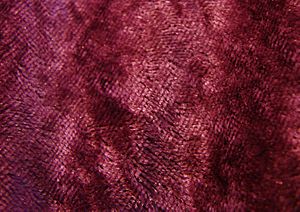Nap (textile) facts for kids
Nap is a special fuzzy surface on some fabrics. Think of it like the soft, raised fibers you feel on a blanket or a carpet. This fuzzy layer makes the cloth feel soft and sometimes look shiny. Velvet is a great example of a fabric that has a nap. Sometimes, "nap" can also mean a type of felt cloth.
In the 14th century, the word "nap" was used to describe how rough a woven cloth felt. This was before the fabric was smoothed out or cut.
What is Fabric Nap?
A fabric's nap is the soft, raised surface you can feel and see. It's made of tiny fibers that stand up from the main part of the cloth. These fibers are usually all pointing in the same direction. This is why some fabrics, like velvet, look different when you brush them one way or the other.
How is Nap Made?
Since the 15th century, the term "nap" often refers to a "pile" on the cloth. A pile means fibers that are added on purpose to create that raised surface. These fibers are not just part of the original weave.
Fabrics with a pile are made in a special way. Often, extra loops of yarn are woven into the fabric. These loops can then be cut to create the fuzzy nap. Or, they can be left as loops, like in a towel. This extra yarn creates the soft, thick surface.
Fabrics with a Piled Nap
Many common items have a piled nap.
- Carpets and rugs are perfect examples. Their soft surface is made from many loops of yarn that are often cut.
- Velvet is a classic fabric with a short, dense nap. It feels very smooth and luxurious.
- Velour is similar to velvet but often made from cotton or polyester. It has a soft, plush feel.
- Velveteen is another fabric that looks like velvet but is usually made from cotton. It has a slightly stiffer nap.
All these fabrics get their unique look and feel from the way their nap or pile is created. It makes them soft, warm, and sometimes very elegant.


